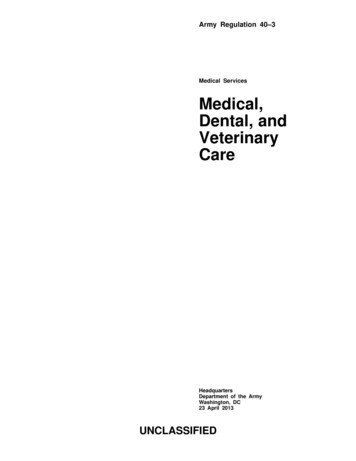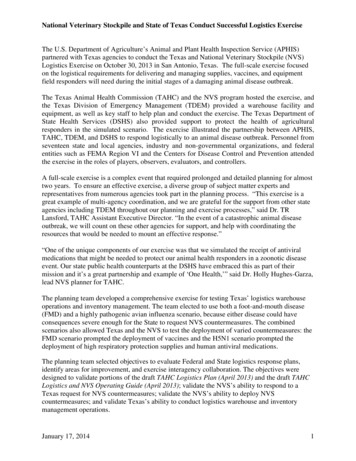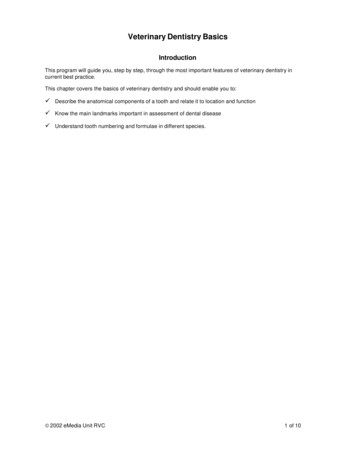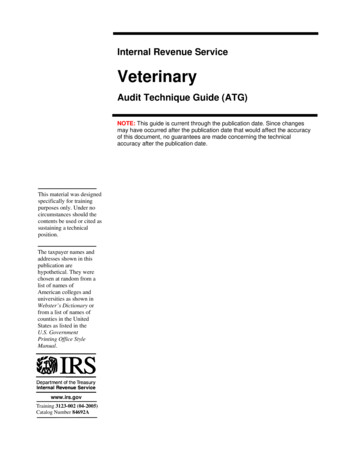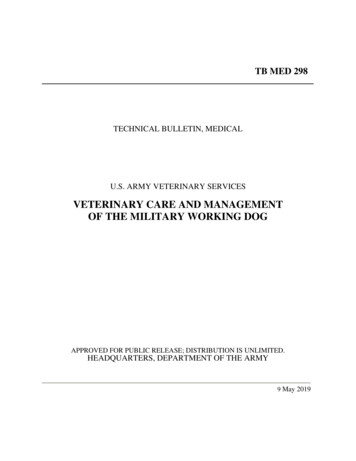
Transcription
TB MED 298TECHNICAL BULLETIN, MEDICALU.S. ARMY VETERINARY SERVICESVETERINARY CARE AND MANAGEMENTOF THE MILITARY WORKING DOGAPPROVED FOR PUBLIC RELEASE; DISTRIBUTION IS UNLIMITED.HEADQUARTERS, DEPARTMENT OF THE ARMY9 May 2019
This page is intentionally left blank.
TECHNICAL BULLETIN, MEDICALTB MED 298DEPARTMENT OF THE ARMYWashington, DC, 9 May 2019VETERINARY CARE AND MANAGEMENTOF THE MILITARY WORKING DOGYou can help to improve this bulletin. If you find any mistakes or have a recommendation toimprove procedures, please let us know. Mail a memorandum or DA Form 2028 (RecommendedChanges to Publications and Blank Forms) directly to the Director, Department of Defense MilitaryWorking Dog Veterinary Service, 1219 Knight St. Building 7602, Joint Base San AntonioLackland, TX 78236.The use of trademarked names does not imply endorsement by the U.S. Army but is intended only toassist in the identification of a specific product.i
TB MED 298ContentsCHAPTER 1 - INTRODUCTIONPurpose and scope, 1-1, page 1References, 1-2, page 1Abbreviations and terms, 1-3, page 1Overview of the DOD MWD Program, 1-4, page 1Other Working Dogs, 1-5, page 4CHAPTER 2 - EQUIPMENT AND FACILITIESPurpose, 2-1, page 6Tiering Standards, 2-2, page 6Equipment Requirements, 2-3, page 6Programs and Funds, 2-4, page 8Special Considerations, 2-5, page 8Medical Supplies, 2-6, page 9Textbooks, 2-7, page 9Periodicals, 2-8, page 10CHAPTER 3 - PREVENTIVE MEDICINE, DEPLOYMENT ISSUES, AND STANDARD PROCEDURESHandling of MWDs, 3-1, page 11MWD Records, 3-2, page 11Preventive Medicine, 3-3, page 14Annual Submission of MWD Blood and Serum for Archival Banking, 3-4, page 17Laboratory, 3-5, page 17Nutrition Issues, 3-6, page 19Vaccination Protocols, 3-7, page 21Medication and MWD Performance, 3-8, page 22Medical Deployability Guidelines, 3-9, page 22Deployment, 3-10, page 24Exercise and the Obstacle Course, 3-11, page 27Working Bite Quarantine, 3-12, page 28CBRN Considerations with MWDs, 3-13, page 28MWD Case Consultation with DODMWDVS, 3-14, page 28MWD Referral to DODMWDVS, 3-15, page 29MWD Referral for Civilian Care, 3-16, page 29Euthanasia or Death of MWDs, 3-17, page 30CHAPTER 4 - EMERGENCY MEDICINEOverview of Emergent and Critical Care, 4-1, page 32Emergency Preparedness is Critical for Success, 4-2, page 32Cardiopulmonary Resuscitation, 4-3, page 33Gastric Dilatation Volvulus (GDV) Syndrome, 4-4, page 33Mesenteric Volvulus, 4-5, page 34Heat Related Injuries, 4-6, page 35Hemorrhagic Shock, 4-7, page 36Upper Airway Obstruction, 4-8, page 36Blunt Chest Trauma, 4-9, page 37Blunt and Penetrating Abdominal Trauma, 4-10, page 38Anaphylactic Shock, 4-11, page 39Insect and Snake Envenomation, 4-12, page 39ii
TB MED 298CHAPTER 5 - COMMON MEDICAL PROBLEMSSkin, 5-1, page 41Ears, 5-2, page 45Eyes, 5-3, page 46Infectious Diseases of MWDs, 5-4, page 47Gastrointestinal Disease, 5-5, page 50Cardiac Disease, 5-6, page 53Respiratory Tract Disease, 5-7, page 55Urogenital Disease, 5-8, page 56CHAPTER 6 - DIAGNOSTIC IMAGINGRadiation Safety, 6-1, page 58Digital Radiography, 6-2, page 58Technique Charts, 6-3, page 60Abdominal Radiography of MWDs, 6-4, page 62Elbow Radiography of MWDs, 6-5, page 63Pelvic Radiography of MWDs, 6-6, page 63Thoracic Radiography of MWDs, 6-7, page 64Spine Radiography of MWDs, 6-8, page 65Radiographic Contrast/Special Procedures, 6-9, page 65Ultrasound, 6-10, page 69CT vs. MRI, 6-11, page 72Computed Tomography, 6-12, page 72Magnetic Resonance Imaging, 6-13, page 74Radiographic Referral Procedures and Practical Teleradiology, 6-14, page 77CHAPTER 7 - SURGERYOverview, 7-1, page 79Tail Amputation, 7-2, page 79Scrotal Ablation, 7-3, page 80Exploratory Laparotomy, 7-4, page 80Intestinal Resection and Anastomosis, 7-5, page 81Gastropexy, 7-6, page 81Partial Gastrectomy, 7-7, page 82Splenectomy, 7-8, page 82Guide to Ordering MWD Videos, 7-9, page 83CHAPTER 8 - DENTISTRYOverview of Dental Care for MWDs, 8-1, page 84Dental Examinations, 8-2, page 84Dental Records, 8-3, page 84Dental Fractures, 8-4, page 84Periodontal Disease, 8-5, page 85Dental Prophylaxis, 8-6, page 86Handler Level Dental Care, 8-7, page 86CHAPTER 9 - PHYSICAL CONDITIONINGOverview, 9-1, page 87Physical Demands on MWDs, 9-2, page 87Musculoskeletal Injuries, 9-3, page 87Physiological Responses to Conditioning, 9-4, page 88Principles of Conditioning, 9-5, page 89iii
TB MED 298Exercise Prescription, 9-6, page 91Conditioning and Injury Prevention in MWDs, 9-7, page 93CHAPTER 10 - BEHAVIORAL MEDICINEBackground, 10-1, page 94Overview of Diagnosis and Treatment, 10-2, page 94Common Problems, 10-3, page 95Evaluation of Behavioral Disorders, 10-4, page 96Medical Causes for Behavior Problems, 10-5, page 96Diagnosis and Initial Treatment, 10-6, page 96Preventative Strategies, 10-7, page 97Consultation and Referral Information, 10-8, page 100CHAPTER 11 - DISPOSITIONDefinition, 11-1, page 102Process, 11-2, page 102Documentation Requirements, 11-3, page 103MWD Transfer/Adoption Guidelines, 11-4, page 105CHAPTER 12 - NECROPSY AND PATHOLOGY SUPPORTActions Prior to Necropsy, 12-1, page 107Necropsy, 12-2, page 107JPC Diagnostic Services and Pathology Support, 12-3, page 110Table ListTable 3-1: Semi-Annual Physical Examination and Health Evaluation, page 16Table 5-1: MWD Treatment and Deployment Guidelines for CHF, page 55Table 5-2: Prostatic Conditions and Findings, page 57Table 9-1: Strengthening Exercises , page 90Table 10-1: Some Drugs Commonly used in the Treatment of Behavioral Problems in MWDs, page 97Figure ListFigure 3-1: Predeployment Processing Algorithm, page 25Figure 5-1: Trypanosoma cruzi Treatment Protocol, page 48AppendicesA. References, page 111B. Sequence of Forms for MWD Veterinary Health Record, page 115C. CPR Algorithm for MWDs, page 117D. Step-by-Step MRI Guidelines, page 118E. Information for Uploading Files for Transfer to Via AMRDEC Safe, page 119F. Example of Attending VCO Disposition Memorandum, page 121G. Example of 64F Disposition Memorandum, page 122H. Example of MWD Medical Deployment Category Memorandum, page 123I. Canine-Tactical Combat Casualty Card (cTCCC), page125Glossary, page 127iv
TB MED 298CHAPTER 1INTRODUCTION1-1. Purpose and scopea. The purpose of this document is to provide basic information pertinent to successfully managing the healthand welfare of Department of Defense (DOD) Military Working Dogs (MWD). The material is directed towardArmy Veterinary Corps veterinarians and animal care technicians, both military and civilian, that have primaryresponsibility for the care of these animals. However, it may be useful to others who work within the working dogcommunity such as handlers, kennel masters (KM), dog-owning unit commanders, MWD program managers, andcivilian veterinarians not employed by the Army providing care for MWDs and other federal working dogs.b. This publication attempts to consolidate medical information, policies, procedures and regulatory directivesspecific to the medical management of MWDs into one document. This document is not, however, intended to be aveterinary medical text, therefore relevant applicable technical resources are essential. Army Veterinary Corps Officershave researched, extracted, and compiled the material from a variety of references from all services and standards ofveterinary practice within the United States. In consonance with the Army Veterinary Medical Standardization Board(VMSB) process, information is evidence-based whenever possible.1-2. ReferencesSee appendix A.1-3. Abbreviations and termsSee the glossary.1-4. Overview of the DOD MWD Programa. Role of Services, Agencies and Organizations. The DOD MWD Program has the participation of all the branchesof the Armed Forces. The United States Air Force (USAF) is the largest user of MWDs and has been designated as theDOD Executive Agent (EA) for the MWD program. The Army is the DOD Lead Agent for veterinary public andanimal health services and as such, works closely with all services to support their respective programs. Specific roles ofthe various service elements include:(1) Office of the Director, USAF Security Forces (USAF/A7S). USAF/A7S acts as the DOD Executive Agentfor Military Working Dogs, represents MWD program interests at the Joint Service level, and designates the DODMWD Program Manager (PM) as Chair of the Joint Services Military Working Dog Committee (JSMWDC). Thisoffice is also responsible for ensuring appropriate coordination between DOD and other federal agencies for utilizationof canine resources to meet security and resource protection requirements.(2) U.S. Army Veterinary Service (AVS). Provides veterinary support to all services and is responsible forensuring MWDs receive full medical care irrespective of installation assigned or facility location. Veterinary CorpsOfficers (VCO) and Civilian Department of the Army General Service Veterinary Medical Officers (GS-VMO) performrequisite exams, treatments and surgery as necessary, specify diets to be fed, advise on operational use, and, in concertwith the owning unit, are responsible for the health and welfare of MWDs at the unit level in accordance with (IAW)applicable service regulations. Civilian Non-Appropriated Fund Veterinary Medical Officers (NAF-VMOs) may providecare to MWDs when VCOs or VMOs are not available on a reimbursable basis. Within this guide, “VCO” means VCOsand GS-VMOs and “technician” means both military Animal Care Specialists (MOS 68T) and Civilian Department ofthe Army veterinary technicians.(3) Joint Services MWD Committee (JSMWDC). This committee, chaired by the DOD MWD ProgramManager, is comprised of MWD program representatives from each military service branch. It meets semiannually todiscuss MWD policy and operational issues to include training requirements, inventory management, unfilled MWDrequisitions, certification procedures, veterinary support, etc. The JSMWDC is the policy development arm of theoverall MWD program. The Director, Department of Defense Military Working Dog Veterinary Service(DODMWDVS), serves on the committee as a voting member.Chapter 11
TB MED 298(4) Air Force Security Forces Center (AFSFC). Headquartered at JBSA-Lackland, TX, this officeadministers the DOD and USAF MWD Programs and coordinates activities with AF major commands (MAJCOMs)and the other services. DOD taskings to support other federal agencies in National Special Security Events andPresidential protection missions originate from U.S. Secret Service (USSS) through this office and are passed on tothe services for execution. This office is also responsible for ensuring appropriate coordination between DOD andother federal agencies for utilization of canine resources to meet security and force protection requirements.(5) Service/Command MWD Program Managers. These individuals are senior personnel with MWD programexperience designated at the headquarters level of their respective services to oversee MWD activities. They coordinateand advise on distribution and disposition of MWDs within their respective service branch or major command. TheProgram Managers are extremely important in their role of coordinating taskings for their MWD teams.(6) 341st Training Squadron (341 TRS). This is the unit designation for the DOD MWD Training Center(commonly referred to as “the Dog Center”) at JBSA-Lackland, TX. It is a subordinate unit of the 37th Training Groupof the 37th Training Wing. Most DOD MWDs and handlers are trained through this unit. The 341 TRS procures, trains,distributes and manages disposition of dogs. The Operations Flight is composed of personnel from all services and isresponsible for all dog and handler training. The Logistics Flight is charged with procuring dogs, conducting trainingevaluations on prospective dogs, shipping and receiving MWDs, and performing kennel care functions (feeding,grooming, cleaning, etc.) to support the dogs at JBSA-Lackland.(7) Department of Defense Military Working Dog Veterinary Service (DODMWDVS). This Army unit is partof the Army Medical Command, but functions operationally as the 341 TRS Veterinary Service Flight (341 TRS/SGV).It has the mission of providing full veterinary support to the MWD Training Center and for comprehensive referral andconsultation service to the MWD program worldwide. The Director, DODMWDVS advises the Defense Health AgencyVeterinary Services (DHAVS) on veterinary aspects of MWD issues and drafts MWD policies for issue by DHAVS.b. Interaction with other Federal Agencies. There is much interaction between the DOD MWD programs and otherFederal Agencies, particularly with the Department of Homeland Security; specifically the Transportation SecurityAgency (TSA), Customs and Border Protection (CBP), and the United States Secret Service (USSS). These groups maywork together with the military services operationally on joint missions, participate in procurement and/or training withthe 341 TRS, and utilize Army Veterinary Services. Provision of veterinary medical care by VCOs is defined byInteragency Agreements (IAG), Memoranda of Understanding (MOU) or Agreement (MOA) between Army MedicalCommand (MEDCOM) and the specific federal agency. VCOs should be familiar with currently applicable care andreimbursement standards for federal non-DOD working dogs in their area. Every effort should be made by veterinaryunits to support these federal canine programs IAW published agreements in the interest of sharing governmentresources; however, this support should be appropriately prioritized with other military responsibilities. These dogs maybe referred to the DODMWDVS for definitive care based on the IAG, but transportation is the responsibility of therespective agency. Generally, agreements will not be created locally by any veterinary organization. However,exceptions may apply so discuss potential new agreements with the chain of command prior to entering into any.(1) Transportation Security Agency. TSA canines are evaluated, procured, medically processed and trained atthe TSA Canine Training Center, JBSA-Lackland, TX. The TSA National Explosives Detection Canine Program trainsand deploys both TSA-led and state and local law enforcement-led canine teams in support of day-to-day activities thatprotect the transportation system. TSA trains canine teams to operate in the aviation, multimodal, maritime, mass transit,and cargo environments. Considered the “center for excellence” for explosives detection canine training, the program isthe largest explosives detection canine program in the Department of Homeland Security and the second largest in thefederal government after the Department of Defense. The TSA has canine teams located at various major transportationfacilities within and outside CONUS to assist in security and explosive detection.(2) U.S. Secret Service. The USSS’s Canine Detection Training Program provides the highest level ofexplosive detection training and produces canine teams that are able to protect the President and our nation’s leaders,visiting heads of state and government, and National Special Security Events, in all environments and under allconditions. Many times, USSS works with DOD MWD teams to perform their mission.(3) United States Customs and Border Protection. The CBP is the unified border agency of the United StatesDepartment of Homeland Security (DHS). CBP Canine Program is headquartered in El Paso, Texas and oversees twotraining delivery sites in El Paso, Texas and Front Royal, Virginia. The primary goal of the CBP Canine Program isterrorist detection and apprehension. The working CBP canine team has become the best tool available to detect andapprehend persons attempting entry to organize, incite, and carry out acts of terrorism. Their secondary goal is detectionand seizure of controlled substances and other contraband. The CBP agriculture detector dog teams are trained at theChapter 12
TB MED 298USDA's National Detector Dog Training Center in Atlanta.c. Functions of MWDs. Since the end of the Vietnam conflict, the operational use of MWDs within the DOD hasessentially been vested in military police/security forces units. In this capacity, MWDs have performed primarily lawenforcement and security functions. The concept of training MWDs for proficiency in two tasks was implemented in themid-1970s and led to the development of the dual trained “patrol-detector dog.” However, conflicts in Iraq andAfghanistan brought other types of dogs into the inventory to serve with non-law enforcement/security personnel andunits. Further, some programs have considerable contractor involvement and are quite different in how they operatefrom the standard MWD which belongs to DOD law enforcement/security units. The following categories of MWDshave been trained and are in the DOD inventory:(1) DOD-owned and DOD-operated program dogs (current programs).(a) Patrol Dogs (PD). MWDs that are trained for the single purpose of performing security and lawenforcement functions such as controlled aggression, scouting, resource protection, building searches, etc. Thesedogs are not trained or certified to detect drugs or explosives. They are utilized for foot patrol in high crime areasand perimeter patrol to augment security programs for resource and personnel protection. These dogs are handledon-leash except when released to interdict a suspect.(b) Patrol/Drug Detector Dogs (PDDD). In addition to patrol capabilities, these dogs are trained todetect illegal drugs.(c) Patrol/Explosive Detector Dogs (PEDD). In addition to patrol capabilities, these dogs are trainedand certified to detect many different explosive substance odors. PEDDs are used to search and secure areas forexplosive devices, particularly aircraft/terminals, VIP offices, vehicles, etc. They are frequently called on to assistthe USSS in providing security and have been used extensively in other counter-terrorism missions.(d) Patrol/Explosive Detector Dogs - Extended (PEDD-E). In addition to PEDD capability, these dogshave been trained to perform their detection function off leash at variable distance from the handler. This is an “addon” capability trained at the Advanced MWD Course. These dogs are trained through periodic use of the electroniccollar. Within the Army, use of the electronic collar is restricted by ALARACT 070/2017 to use by/for dog teamsspecifically trained at the Advanced MWD Course. Note: VCOs should consider discussing host nation regulationsaddressing electronic collar use with KMs or MWD PMs. Technically, this is outside the responsibility of the VCObut is important for situational awareness.(e) Explosive or Drug Detector Dogs (EDD or DDD). A small number of single-purpose detector dogsare trained each year. Sporting breeds and occasionally small terriers may be used for this category of MWD. Thedogs are only trained for detection of either explosives or narcotics. These dogs are handled on-leash to search.(f) Specialized Search Dogs (SSD). These dogs are trained to detect explosives and generally arehandled off-leash to search. Currently they are found in the United States Marine Corps (USMC) only.(g) Mine Detection Dogs (MDD). These dogs are trained to detect explosives (mines) in a minefieldand are handled on-leash to search. The method employed for searching is generally in a straight line clearing anarrow path. Currently they are found in the Army only.(h) Combat Tracker Dog (CTD). These dogs are trained to track human scent and are handled offleash. Currently they are found in the USMC only.(i) Multi-Purpose Canine (MPC). These dogs can perform patrol and detection duties and are utilizedwithin Special Operations Forces. The MPCs procurement and disposition process is through the SOF and notthrough the 341 TRS. The SOF unit’s VCO provides much of their medical care, but they can be seen at a VTF andare authorized care identical to traditional MWDs.(2) DOD-owned, contractor-operated program dogs. (Note that these programs have been deactivated and nod
discuss MWD policy and operational issues to include training requirements, inventory management, unfilled MWD requisitions, certification procedures, veterinary support, etc. The J SMWDC is the policy development arm of the overall MWD program. The Director, Department of Defense

